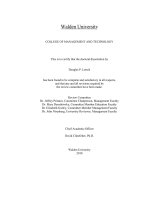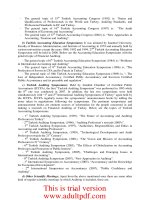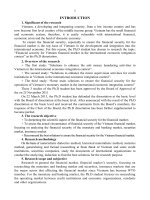Financial accounting in an economic context 8e chapter 010
Bạn đang xem bản rút gọn của tài liệu. Xem và tải ngay bản đầy đủ của tài liệu tại đây (802.66 KB, 26 trang )
1
Chapter 10
Introduction to Liabilities: Economic
Consequences, Current Liabilities
and Contingencies
2
Liabilities
What is a liability?
– “Probable future sacrifice of economic benefits
arising from present obligations of a particular
entity to transfer assets or provide services to
other entities in the future as a result of past
transactions or events.”
3
Liabilities
4
Reporting Liabilities on the Balance Sheet:
Economic Consequences
Shareholders and investors
– interest expense is tax deductible, but more debt means
more risk to shareholders
– equity ownership is subordinated to creditors
Creditors
– restrictive covenants regarding debt limits
Management
– wants to minimize debt on the balance sheet
– often looks for “off-balance sheet” financing
– less debt now improves ability to borrow in the future
5
Current Liabilities
6
Current Liabilities
Classification
– expected to require the use of current assets (or the
creation of other current liabilities) to settle the
obligation.
Valuing current liabilities on the balance sheet
– Ignore present value (report at face value)
Reporting current liabilities
– Primary problem is ensuring that all existing current
liabilities are reported on the balance sheet.
7
Figure 10-3
8
Determinable Current Liabilities
1. Accounts payable (Ch 7)
2. Short-term notes
3. Current maturities of long-term debts
4. Dividends payable
5. Unearned revenues (Ch 5)
6. Sales tax payable
7. Income taxes payable (App 10B)
8. Payroll taxes payable
9
Determinable CL - continued
Accrued liabilities - accrue expense and liability
at the end of the current period, and usually
paid sometime during the next year. For each
item, debit expense and credit liability.
Examples include:
– Wages payable
– Salary payable
– Interest payable
– Rent payable
– Insurance payable
– Property taxes payable
– Employee bonuses
10
Incentive Compensation
11
Contingent Liabilities
Contingent on some future event or activity in order
to know the exact amount.
Examples: warranties, coupons and lawsuits
Changes in estimate may be made in subsequent
periods, when future event is concluded.
Under IFRS, much of these transactions are reported
in a balance sheet account called “provisions”.
–Provisions are more readily booked than contingent liabilities
because IFRS provisions are accrued when the obligation is
“more likely than not,” while under US GAAP contingent liabilities
are accrued when “highly probable,” which is a much higher
threshold.
12
Figure 10-5
13
Contingent Liabilities
Warranties
– Uncertain future costs
– Record estimated expense and liability when products
are sold (matching concept):
Warranty Expense
Estimated Warranty Liability
xx
xx
– As costs are incurred (usually in subsequent periods),
charge expenditure to warranty liability:
Estimated Warranty Liability
xx
Cash, etc.
xx
14
Class Problem: P10-4, Parts a & b:
Issues and recommendations:
- Likelihood?
Probable
- Disclose?
Yes
- Disclosure?
Indicate range and level of probability
(250,000 – 1.5 million)
- Accrue?
Since probable (or greater) and
estimable, accrual is required, based on
best estimate.
15
Class Problem: P10-4, Part c:
Adjusting journal entry for 2011:
Estimated loss
742,000
Estimated liability
742,000
(Best guess in the range)
Journal entry at settlement (8/12/12):
Estimated liability
742,000
Recovery of estimated loss 52,000
Cash
690,000
16
Warranty
A promise by a manufacturer or seller to ensure
the quality or performance of the product for a
specific period of time
Almost Honest
JOHN’S
Used Cars
I’ll stand behind it
for 50 miles
or 50 minutes
whichever comes first
17
Class Exercise: E10-10(a)
(1) GJE to record sale in 2011 (200 @ $250 each):
Cash
50,000
Sales revenue
50,000
(2) AJE in 2011 to record estimated warranty for the
sales (200 @ $20):
Warranty expense 4,000
Estimated Warr. Liability 4,000
(3) GJE to record payment in 2011 for repairs:
Est. Warr. Liability 1,400
Cash
1,400
GJE to record payment in 2012 for repairs:
Est. Warr. Liability 2,600
Cash
2,600
18
Class Exercise: E10-10(b)
Income effects for the revenue and warranty
expense under the two alternative for recognition
of expense (expressed in thousands):
Paid
Accrue Expense
2011
Revenues
50,000
Warr. Expense (4,000)
2012
-----
Expense as
2011
2012
50,000
--(1,400) (2,600)
Note that the accrual method recognizes the
expense in the same period as the revenues
generated by the sale.
19
Retirement Costs (App 10A)
Defined Contribution Plans
– Less expensive than Defined Benefit Plans
– 401(k), 403(b), 457
– The entry to record period contributions is very
simple:
Dr. Pension Expense
Cr. Cash
Defined Benefit Plans
– Benefits must be predicted, therefore several assumptions
and estimates are required
– Social Security is form of Defined Benefit Plan
– The entry to record the estimated liability is simple, but
the calculations can be quite complicated:
Dr. Pension Expense
Cr. Pension Liability
20
Deferred Taxes (App 10B)
Generated by the discrepancy between income
and expenses for taxation (specified by IRS) and
financial reporting (specified by GAAP).
Example:
– Equipment purchased on 1/1/09 for $9,000
– 3-year useful life
– no salvage value
– DDB for income tax purposes
– SL for financial reporting purposes
– Income tax rate of 30%
21
Depreciation Schedules
Year
DDB
SL
2009
$6000
-
3000
= $3000
X 30%
= $900
2010
2000
-
3000
= (1000)
X 30%
= (300)
2011
1000
-
3000
= (2000)
X 30%
= (600)
Total
$9000
$9000
Diff
Rate
Tax Benefit
(Disbenefit)
$0
$0
2009 Deferred income tax liability $900
2010 Deferred income tax benefit $300
2011 Deferred income tax benefit $600
22
Deferred Income Tax Liability
23
The Conservatism Ratio
24
The Conservatism Ratio
25









